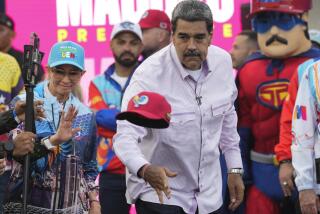U.S. Agents See Bolivia Success Despite Errors
CAMP EL ZORRO, Bolivia — Two special agents of the U.S. Drug Enforcement Administration said Tuesday that the U.S.-Bolivian campaign against clandestine cocaine laboratories here has been plagued with logistical problems and errors in intelligence, but they said it should still be able to achieve success.
The two agents, wearing jungle camouflage gear and pistols in their belts, talked in a grove of tropical trees where special anti-drug forces of the Bolivian national police, backed by U.S. pilots and personnel, on Friday raided a major cocaine laboratory, called Target 37 in the code language of the operation.
The U.S.-Bolivian force has conducted five raids since last Friday, but the laboratory here has been its only major find. No cocaine has been confiscated, and only one person, a 17-year-old ranch hand, has been arrested.
‘Knew We Were Coming’
“They knew we were coming, and the drug traffickers got away,” said one of the special agents. “But if we can keep this operation going for 60 days, it will make a big dent in Bolivia’s cocaine production this year.”
This laboratory was found 185 miles due north of Trinidad, the capital of Bolivia’s Beni department, which borders Brazil. The laboratory, covered by dense foliage in a grove of yellow-flowered tajibo and tall, white-trunked motojobo trees, was detected because of the 1,000-foot-long runway of beaten earth next to the clump of trees.
In the other raids carried out with U.S. Army Black Hawk helicopters, the Bolivian anti-drug officers, known as Leopards, have been unable to find cocaine at two suspected storage sites or at two other sites believed to be laboratories.
Intelligence Criticized
Maj. Carlos Vizcarra, the deputy commander of the Bolivian anti-narcotics police unit here, was critical of the intelligence procedures for locating the sites of raids. He said the targets were being selected exclusively by DEA special agents, without consulting with the Bolivian police. “They don’t trust us Bolivians,” said Vizcarra.
The two U.S. special agents, who asked not to be identified by name, said there was an intelligence failure in the selection of a raid target on Sunday. Three helicopters, loaded with more than 30 Bolivian police, went to a site based on coordinates given by the DEA agents. No laboratory was found.
“In this huge area, it is sometimes easy to lose the location of a target. We need to have more small aircraft here that can land on rough jungle runways, to do more systematic reconnaissance work,” said one of the special agents.
But both agents said there are many additional targets that have been identified on which raids will be carried out during the coming weeks.
Keeping Them ‘Off Balance’
“This is going to keep anyone who is trying to produce cocaine here off balance,” said one agent. “Most of the labs have probably shut down, but they will not be able to reopen here if our surveillance and raids continue.”
The operation, code-named “Blast Furnace,” got off to a shaky start. It was originally to have got underway July 4 but was delayed until July 14.
According to the two DEA special agents, the operation was delayed because of a petroleum workers’ strike here that prevented stockpiling of enough aviation fuel to fly the U.S military aircraft involved.
The arrival of a huge C-5A Galaxy U.S. Air Force transport on July 14 at the international airport of Santa Cruz, the main city of eastern Bolivia, destroyed the operation’s secrecy.
There were further delays after the Galaxy unloaded the six U.S. helicopters that were to be moved to an advance base in the Beni department, where most of the clandestine laboratories are located.
Problems With Fuel
Two days were lost because Bolivian transport planes were unable to carry aviation fuel in plastic containers to the advance base north of Trinidad.
After the first raid on Friday found the laboratory here, further raids scheduled for Sunday and Monday had to be delayed because a C-47 transport plane, required to carry fuel for the helicopters in case of refueling, broke down and could not be immediately repaired.
“We don’t expect to find cocaine or traffickers now at the labs where we will be carrying out raids in the future,” said one of the special agents, who goes by the nickname of Buffalo.
“But the more reconnaissance we now conduct in this area, the more likely we will be able to find the laboratories and storage bases that we are seeking to destroy,” he said.
The DEA estimates that there are 100 laboratories, some modern and sophisticated, and others small but difficult to locate, in the desolate Beni region, which covers an area the size of the state of Nebraska.
But the special agents--one based in Bolivia, the other in Washington--said they are confident that the operation will be able to disrupt production from Bolivia, which is estimated to supply at least 25% of the cocaine in world trade.
This is the dry season in the Beni, a flat tropical area where brown rivers meander through savannahs of tall grass and patches of dense forest.
1,000 Air Strips
In the wet season, the waters of the rivers, such as the Mamare, which flows past this camp, flood the area for six months. But now, in the dry season, the region is accessible to small aircraft that land at more than a thousand air strips which are scattered through the region.
“The drug operators who run the labs can only produce here when the planes can land before the rains begin in September. If we break the production chain here, their exports will be reduced and they will lose a year of activity,” said Buffalo.
At a press conference in Trinidad, Bolivian Minister of the Interior Fernando Barthelemy and Maj. Gen. James Taylor, the U.S. military commander for more than 160 Army personnel here, gave a joint assessment of the initial results of the operation.
Barthelemy said the operation, accompanied by arrests of suspected drug traffickers in Santa Cruz, has “stopped the traffic of cocaine from Bolivia.”
“This is not a war with dead and wounded,” Barthelemy continued. “What we are doing is destroying laboratories and arresting common criminals.”
“The drug traffic is an aggression against Bolivia. It is managed by foreigners. This aggression constitutes something far more damaging for us than any criticism that can be made of the assistance that we are receiving for this struggle from the United States,” Barthelemy said.
Taylor said that the 160 soldiers from the 193rd Brigade in Panama, who came here along with the helicopters and supporting Air Force personnel, were here at the invitation of the Bolivian government to participate in the anti-drug effort.
The agreement provides that the helicopter force and the supporting personnel, including Army security guards, can remain here for up to 60 days, but the operation will be reviewed every 15 days to determine how long the U.S. forces will remain.
Barthelemy said that 15 suspected drug traffickers were arrested in Santa Cruz over the weekend and 10 others who were sought had not been found.
“I think those who were arrested are quite important,” said Barthelemy, although he admitted that some of the biggest suspected Bolivian drug traffickers had “left the country or are underground now.”
“The fact that they are underground or have disappeared is already a success for the operation, because that means that they cannot continue running their drug smuggling operations here,” he continued. “Their mechanism has been broken and their leaders are on the run.”
More to Read
Sign up for Essential California
The most important California stories and recommendations in your inbox every morning.
You may occasionally receive promotional content from the Los Angeles Times.










